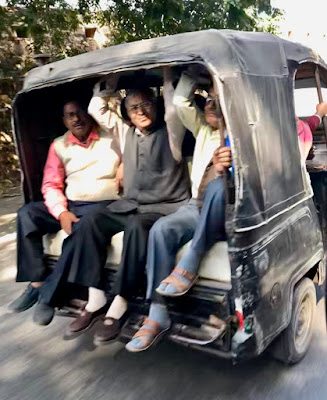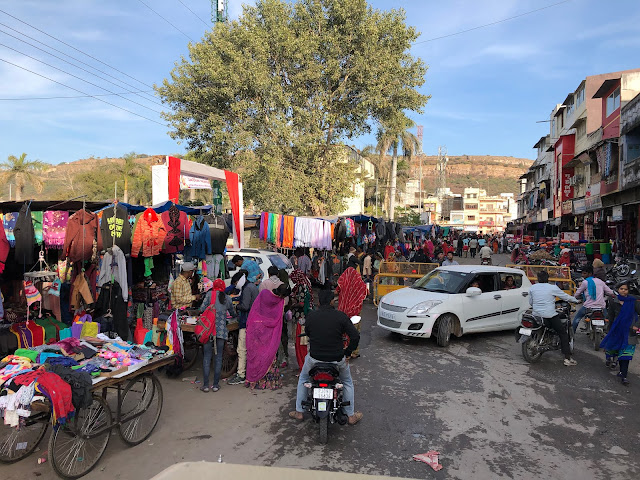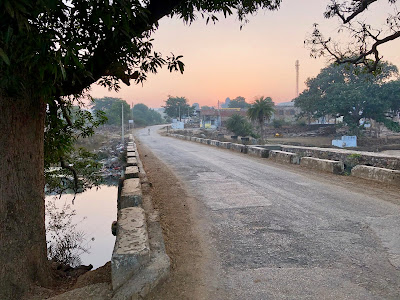7. Chittaurgarh
Chittaurgarh
We were picked up in a couple of jeeps for our hours drive to Chittaugarh. The drive over was very scenic, and at the top of most hills was a temple, but the levels of pollution were clearly visible.
A lovely drive down towards chittaurgarh
The huge Chittaurgarh Fort, 13 kms in circumference, looks down at the city below
Daily life as we passed by. I think the sacking was probably being used to slow the drying time of the concrete that was being laid. The area is famous for local marble and granite its many cement factories.
The Fort
Now this was a surprise - it is the largest fort not just in India but in all of Asia, and is now a UNESCO world heritage site. Ashamedly I had never even heard of it! It is spread over an area of nearly 700 acres on top of a hill over looking the plains of a valley. This fort was built by various Maurya rulers in the 7th Century. It has several historical palaces, gates, temples and two prominent commemorative towers. The fort has been the site of three major sieges - 1303, 1535 and 1567 by Muslim invaders and its Hindu rulers fought fiercely to maintain their independence. On more than one occasion the men fought to death while the women committed mass suicide or "jauhar".
Chittorgarh Fort has received the credit of being the largest fort of India. The massive fort is located on a high hill near the Gambheri River in Chittorgarh. Chittorgarh Fort lies at a distance of 112 kms from the city of Udaipur in Rajasthan. This fort was built by various Maurya rulers in the 7th century. This huge fort covers an area of 700 acres, extending to 3 kms in length and 13 kms in peripheral length. Standing on an elevated hill of 180m, the impregnable fort has witnessed three battles.
Chittaurgarh Fort is truly an embodiment of chivalry and pride of the Rajputs. The fort has a long story of romance, courage, determination and sacrifice. A glimpse of the fort still makes one to think the glory of the Rajputs who once lived here. The imposing Fort boasts of well-designed palaces, magnificent cenotaphs and huge towers. The Fort of Chittorgarh has a colossal structure that is secured by its several strong gateways.
Chittorgarh Fort is an acknowledgement to the courage of the gallant Rajput rulers who sacrificed their life combating dominant rivals instead of surrendering before them.
The fort was attacked three times and every time it got saved by the daring heroism of the Rajput warriors. In 1303, for the first time, this fort was attacked by Allaudin Khilji to fulfill his desire to make off with Rani Padmini. For the second time, the Fort was sacked by Sultan Bahadur Shah of Gujarat in 1535. In 1567, it was attacked for the last time by Mughal Emperor Akbar to conquer Maharana Udai Singh. Every time, a jauhar (mass suicide) was observed and the womenfolk of the Royalty never submitted themselves.
The Fort is surrounded by a 13km perimeter wall on top of a 45 degree slope making it almost impenetrable. The ascent passes through 7 gateways, built in the 15th century. These gates are called, from the base to the hill top, the Paidal Pol, Bhairon Pol, Hanuman Pol, Ganesh Pol, Jorla Pol, Laxman Pol, and Ram Pol, the final and main gate.
The fort has two famous towers, Kirti Stambha (The Tower of Fame) and Vijay Stambha (The Tower of Victory), both depict the glorious history of the Rajput rulers.
Kirti Stambha (Tower of Fame)
This 72 foot tower was built in the 12th Century and is therefore older and smaller than the Victory tower. It is dedicated to Adinath, the first Jain thinker and adorned with Jain sculptures. A narrow staircase and 54 steps leads through the 6 storeys to the top, where a pavilion was added with 12 columns in the 15th Century. Adjacent to the tower is a Jain Temple.
The Tower of Fame
The Jain Temple

Vijay Stambha (The Tower of Victory)
Built over a period of ten years between 1458 to 1468 by Rana Kumbha to commemorate his victory over Mahmud Khalji, the Sultan of Malwa. 122 feet high, 157 steps over 8 floors. The dome, added later, was damaged by lighting and repaired during the 19th century. The outside is adorned with sculptures of the Hindu gods. There are lots of black faced monkeys in the surrounding garden.
The Tower of Victory

The view out over the plain is amazing and from the fort it would have been possible for all the inhabitants to watch the battle unfold below them.
To secure the huge gateways from being rammed by the elephants of an attacking army, huge spikes were attached to the doors at elephant head height.


Padmini's Palace
A 19th century reconstruction of the 3 storied structure. According to legends, it was here that Alauddin was permitted to glimpse the mirror image of Rani Padmini, wife of Maharana Rattan Singh. Just one glimpse of Padmini's beauty besotted him and convinced him to destroy Chittor in order to possess her. Maharana Rattan Singh was killed and Rani Padmini allegedly committed Jauhar. Rani Padmini's beauty has been compared to that of Cleopatra and her life story is an eternal legend in the history of Chittor and recently the subject matter of a controversial film.
Stil on the theme of water .... One of the real strengths of this fort was its ability to provide 84 bodies of water in the form of ponds, wells and reservoirs, of these, 22 still remain. They were fed by natural catchment and rainfall and had a combined storage of 4 billion litres that would provide water for an army of 50,000 and the supply could last for years. The Gamukh reservoir is near the Tower of Victory, spring fed, it was one of the major sources of water during the numerous sieges.
The Gaumukh Reservoir

After seeing the fort we went into Chittorgarh to choose material for our saris for our New Year celebrations.
So much beautiful fabric .... how to choose? The fabric comes in one long piece - the end is decorated differently and they use that part to make the fitted bodice part which was made up for us by women from Bijaipur.
Every year the Fort and city of Chittorgarh host "Jauhar Mela", the biggest Rajput festival. It is generally believed to commemorate Padmavati's jauhar but also many Rajputs, including descendants of the princely families celebrate the bravery of their ancestors and remember all 3 jaguars that happened at the Fort. It has also become a forum to air views on the current political situation in the country.





























Comments
Post a Comment